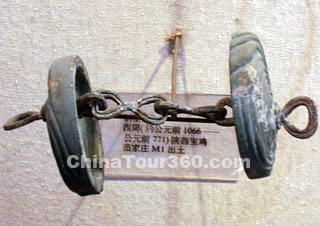The Zhou Dynasty includes two periods: Western (11th century BC to 771 BC) and Eastern Zhou (770 BC to 221 BC). It is so divided because the Western Zhou Dynasty's capital Haojing (in present Xian of Shaanxi Province) lies to the west of the Eastern Zhou's capital Luoyi (present Luoyang in Henan Province).

Funerary-Horse Tunnel of the Zhou Dynasty
Zhou was a small country in the western area of the Shang Dynasty (17th century BC to 11th century BC). By the 11th Century BC, Zhou had become increasingly powerful and extended throughout the present Shaanxi Province, thus posing a threat to the Shang Dynasty. This was a constant source of conflict between the two groups, which intensified and resulted in numerous wars. Eventually, Western Zhou was established by the Emperor Wu (also called 'Zhou Wuwang') in 1046 BC. Zhou reigned about 800 years and was the longest-ruling dynasty in Chinese history.
The Eastern Zhou Dynasty was ruled by Emperor Ping (Zhou Pingwang). After the interior war, it was divided into the Spring and Autumn Period (770BC - 476BC), and the Warring States Period (476BC - 221BC). Each of the periods were characterized by turbulent wars and featured renowned strategists. When the dynasty progressed into the Spring and Autumn Periods, slave society came to an end and a totally new society feudal society was gradually formed.
![]() Economy
Economy
The Western Zhou Dynasty adhered to the Square-Field System of economics in order to guarantee state ownership of the land. During the last period of Western Zhou Dynasty, ironware began to be used. The merits of iron farm tools were noted and these were used increasingly in the Eastern Zhou Dynasty. Furrow Plowing by Cattle appeared and promoted the development of agricultural technology in that period. The emergence of Water-Saving Irrigation also assisted the agriculture development. The most notable hydraulic project during the Warring States Period was Dujiangyan Irrigation System. During the later Warring States Period, state ownership of the land was replaced by feudal land ownership due to the economic institutional reform.
The handicraft industry was in boom during the Eastern Zhou Dynasty. Techniques for the processing of malleable cast iron appeared around this time, about 2,000 year earlier in China than in Europe. Bronze smelting techniques were innovative and resulted in the finest products around at the time e.g. square pots with designs of lotus and cranes made in the middle period of the Spring and Autumn Period. The textile, salt and wine-making industries were also in progressing at great speed.
![]() Philosophy
Philosophy
The Zhou Dynasty was especially noted for it brilliant achievements in culture, during this special period of the great social change. Its great philosophers include: Lao Zi who wrote A Book of Tao (Tao Te Ching); Confucius (551BC - 479BC) who wrote The Analects. At the same time, the 'Contention of A Hundred Schools of Thought' appeared and they were the convincing evidence to the prosperous philosophy in the Eastern Zhou Dynasty.

A Part of Chariot of the Western Zhou Dynasty
![]() Art
Art
Brushwork became an unattached art during the Spring and Autumn Period and Warring States Period and mainly took the form of silk paintings and murals. We know that music and musical instruments were constantly being developed during this time, from archaeological findings such as the Bronze Chime Bells which were unearthed in Suizhou of Hubei.
![]() Science
Science
The world earliest treatise on astronomy, Gan and Shi's Astronomy Book, was composed during the time of the Warring States. Mo Jing (Mo Zi's work on physics) recorded the dynasty's achievements in that field.
![]() Medicine
Medicine
Bian Que was a famous doctor active during the Warring States Period and who used the 'Four Diagnostic Method' of Look, Hear, Ask and Feel in order to diagnose diseases. It was Bian Que who pioneered the now well-known test of feeling a patient's pulse when making a diagnosis. These four diagnostic methods have been used by Chinese herbalist doctors for over two thousand years.
![]() Go to the Spring and Autumn Period
Go to the Spring and Autumn Period







